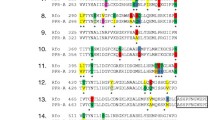Summary
Male sterile plants appeared in the progeny of three fertile plants obtained after one cycle of protoplast culture from a fertile botanical line and two androgenetic lines ofNicotiana sylvestris. These plants showed the same foliar and floral abnormalities as the cytoplasmic male sterile (cms) mitochondrial variants obtained after two cycles of culture. We show that male sterility in these plants is controlled by three independent nuclear genes,ms1, ms2 andms3, while no changes can be seen in the mitochondrial genome. However, differences were found between thein organello mitochondrial protein synthesis patterns of male sterile and parent plants. Two reproducible changes were observed: the presence of a new 20 kDa polypeptide and the absence of a 40 kDa one. Such variations were described previously in mitochondrial protein synthesis patterns of the cms lines. Fertile hybrids of male sterile plants showed normal synthesis patterns. The male sterile plants are thus mutated in nuclear genes involved in changes observed in mitochondrial protein synthesis patterns.
Similar content being viewed by others
References
Belliard G, Vedel F, Pelletier G (1979) Mitochondrial recombination in cytoplasmic hybrids of Nicotiana tabacum by protoplast fusion. Nature 281:401–403
Boutry M, Faber AM, Charbonnier M, Briquet M (1984) Microanalysis of plant mitochondrial protein synthesis product. Plant Mol Biol 3:445–452
Cooper P, Newton KJ (1989) Maize nuclear background regulates the synthesis of a 22-kDa polypeptide inZea luxurians mitochondria. Proc Natl Acad Sci USA 86:7423–7426
De Paepe R, Nitsch C, Godard M, Pernès J (1977) Potential from haploids and possible use in agriculture. In: Barz W, Reinhard E, Zenk MH (eds) Plant Tissue Culture and its Bio-Technological Applications. Springer-Verlag, Berlin, Heidelberg, pp 341–352
De Paepe R, Bleton D, Gnangbe F (1981) Basis and extent of genetic variability among doubled haploid plants obtained by pollen culture inNicotiana sylvestris. Theor Appl Genet 59:177–184
Dewey RE, Timothy DH, Levings CS (1987) A mitochondrial protein associated with cytoplasmic male sterility in the T cytoplasm of maize. Proc Natl Acad Sci USA 84:5376–5378
Forde BG, Leaver CJ (1980) Nuclear and cytoplasmic genes controlling synthesis of variant mitochondrial polypeptides in male sterile maize. Proc Natl Acad Sci USA 75:3841–3845
Fox TD, Costanzo MC, Strick CA, Marykwas DL, Seaver EC, Rosenthal JK (1988) Translational regulation of mitochondrial gene expression by nuclear genes ofSaccharomyces cerevisiae. Philos Trans R Soc Lond [Biol] 319:97–105
Hanson MR, Conde MF (1985) Functioning and variation of cytoplasmic genomes: lessons from cytoplasmic-nuclear interactions in affecting male fertility in plants. Int Rev Cytol 94:213–267
Hiesel R, Schobel W, Schuster W, Brennicke A (1987) The cytochrome oxidase subunit I and subunit III genes inOenothera mitochondria are transcribed from identical promoter sequences. EMBO J 6:29–34
Kaul MLH (1988) Male sterility in Higher Plants. In: Frankel R, Grossman M, Linskens HF, Maliga P, Riley R (eds) Monographs on Theoretical and Applied Genetics, vol 10. Springer-Verlag, Berlin, Heidelberg, pp 775–797
Laemmli UK (1970) Cleavage of structural proteins during the assembly of the head of bacteriophage T4. Nature 227:680–685
Levings CS, Brown GG (1989) Molecular biology of plant mitochondria. Cell 56:171–179
Li XQ, Chétrit P, Mathieu C, Vedel F, De Paepe R, Rémy R, Ambard-Bretteville F (1988) Regeneration of cytoplasmic male sterile protoclones ofNicotiana sylvestris with mitochondrial variations. Curr Genet 13:261–266
Maniatis T, Fritsch EF, Sambrook J (1982) Molecular cloning: a laboratory manual. Cold Spring Harbor Laboratory Press, Cold Spring Harbor, New York.
Newton KJ, Walbot V (1985) Maize mitochondria synthesize organ-specific polypeptides. Proc Natl Acad Sci USA 82:6879–6883
Prat D (1983) Genetic variability induced inN. sylvestris by protoplast culture. Theor Appl Genet 64:223–230
Rottman WH, Brears T, Hodge TP, Lonsdale DM (1987) A mitochondrial gene is lost via homologous recombination during reversion of CMS-T maize to fertility. EMBO J 6:1541–1546
Tzagoloff A, Myers AM (1986) Genetics of mitochondrial biogenesis. Annu Rev Biochem 55:249–285
Author information
Authors and Affiliations
Additional information
Communicated by R.G. Herrmann
Rights and permissions
About this article
Cite this article
De Paepe, R., Chétrit, P., Vitart, V. et al. Several nuclear genes control both male sterility and mitochondrial protein synthesis inNicotiana sylvestris protoclones. Mol Gen Genet 222, 206–210 (1990). https://doi.org/10.1007/BF00633819
Received:
Issue Date:
DOI: https://doi.org/10.1007/BF00633819




